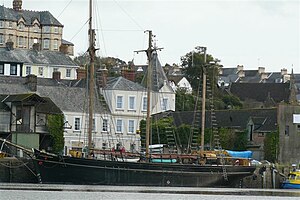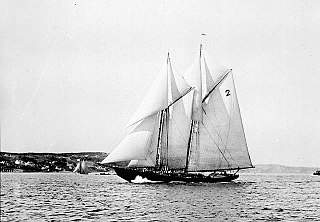
Bluenose was a fishing and racing gaff rig schooner built in 1921 in Lunenburg, Nova Scotia, Canada. A celebrated racing ship and fishing vessel, Bluenose under the command of Angus Walters, became a provincial icon for Nova Scotia and an important Canadian symbol in the 1930s, serving as a working vessel until she was wrecked in 1946. Nicknamed the "Queen of the North Atlantic", she was later commemorated by a replica, Bluenose II, built in 1963. The name Bluenose originated as a nickname for Nova Scotians from as early as the late 18th century.

Appledore is a village at the mouth of the River Torridge, about 6 miles (10 km) west of Barnstaple and about 3 miles (5 km) north of Bideford in the county of Devon, England. It is the home of Appledore Shipbuilders, a lifeboat slipway and Hocking's Ice Cream, a brand of ice cream only sold in North Devon. There are numerous shops, cafes and galleries. The local football club is Appledore F.C. The ward population at the 2011 census increased to 2,814.
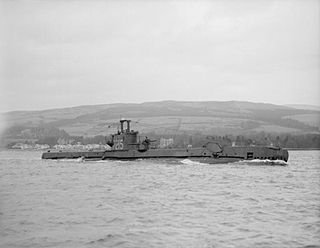
HMS Sceptre (P215) was a third-batch S-class submarine built for the Royal Navy during World War II. Completed in April 1943, she spent the majority of her career in the North Sea, off Norway. After an uneventful patrol, the submarine participated in Operation Source, an attack on German battleships in Norway using small midget submarines to penetrate their anchorages and place explosive charges. However, the midget submarine that she was assigned to tow experienced technical difficulties and the mission was aborted. During her next four patrols, Sceptre attacked several ships, but only succeeded in severely damaging one. She was then ordered to tow the submarine X24, which was to attack a floating dry dock in Bergen. The operation, codenamed Guidance, encountered difficulties with the attacking submarine's charts, and the explosives were laid on a merchant ship close to the dock instead. The dock was damaged and the ship sunk, and X24 was towed back to England. Sceptre then conducted a patrol in the Bay of Biscay, sinking two German merchant ships, before being reassigned to tow X24 to Bergen again. The operation was a success, and the dry dock was sunk.

HMAS Swan, named for the Swan River, was a River-class destroyer escort of the Royal Australian Navy (RAN). Constructed in Melbourne following the loss of HMAS Voyager, Swan entered service in 1970.
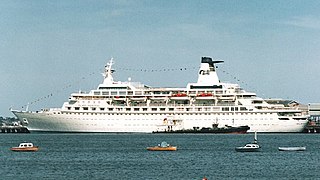
The MV Discovery was a cruise ship, which was formerly operated by Voyages of Discovery and was last in service for Cruise & Maritime Voyages. She was scrapped in Alang, India as Amen in 2014.

The S.S.S.Lotus is a historic gaff rigged schooner. Her home port is Sodus Bay in Wayne County, New York, United States. She is owned and operated by the "Friends of the Schooner Lotus."
Appledore Shipbuilders is a shipbuilder in Appledore, North Devon, England.

The Alma Doepel is a three-masted topsail schooner and is one of the oldest such ships surviving.

Adventure is a gaff rigged knockabout schooner. She was built in Essex, Massachusetts, USA, and launched in 1926 to work the Grand Banks fishing grounds out of Gloucester. She is one of only two surviving knockabout fishing schooners – ships designed without bowsprits for the safety of her crew.
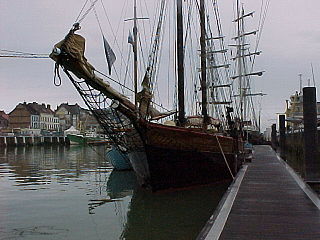
The Johanna Lucretia is a British tall ship and is an oak wooden two masted topsail schooner built at the Rhoos Shipyard, Ghent in Belgium in 1945. The Johanna Lucretia measures 96 ft (28.65m) in length, her beam is 18 ft (5.50m), her draught is 8 ft (2.45m) and she has a total sail area of 380 m2.
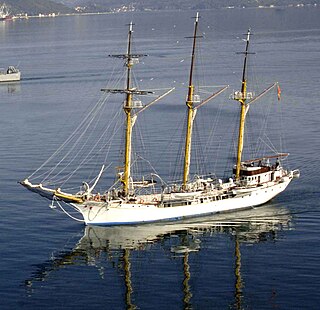
Jadran is a sailing ship for basic naval training built for the Yugoslav Royal Navy and currently in Montenegrin Navy service. A three-mast topsail schooner or barquentine with an auxiliary engine, Jadran was built in Hamburg, Germany between 1930 and 1933, and commissioned on 19 August 1933. Prior to World War II she completed seven long training cruises with trainees from the Yugoslav Naval Academy, including one to North America. As Yugoslavia was neutral at the outbreak of World War II, Jadran was able to conduct short cruises in the Adriatic Sea. In April 1941, Yugoslavia was invaded by the Axis powers, and Jadran was captured and renamed Marco Polo by the Italian Navy. She continued to be used as a training ship in the Adriatic, operating out of the Istrian port of Pola, and was featured in an Italian propaganda film.

Amazon is a 102-foot (31 m) long screw schooner and former steam yacht built in 1885 at the private Arrow Yard of Tankerville Chamberlayne in Southampton.

HMS Endeavour replica is a replica of HMS Endeavour, the bark commanded by Lieutenant James Cook when he charted New Zealand and the eastern coast of Australia.

Cymric was a British and Irish schooner, built in 1893. She joined the South American trade in the fleet of Arklow, Ireland, in 1906. She served as a British Q-ship during the First World War; she failed to sink any German U-boats, but did sink a British submarine in error.

James Postlethwaite was a schooner, launched in 1881. She operated out of Arklow after 1909. She was in Hamburg on the day that Britain entered the First World War with its declaration of war against Germany. Her crew was imprisoned and she was impounded and used as a barge to carry munitions.
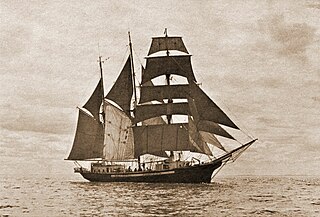
The sailing ship Regina Maris was originally built as the three-masted topsail schooner Regina in 1908. She was a 144-foot (44-meter), wooden, completely fore-and-aft–rigged sailing ship with three masts. She was re-rigged in 1963 as a 148-foot (45-meter) barquentine. Regina Maris could reach a speed of up to 12 knots, especially on a half-wind course or with a fresh back-stay breeze.

Result is a three-masted cargo schooner built in Carrickfergus in 1893. She was a working ship until 1967, and served for a short time in the Royal Navy as a Q-ship during World War I. She currently rests on land at the Ulster Folk and Transport Museum, and in 1996 was added to the National Register of Historic Vessels.

Sherman Zwicker is a wooden auxiliary fishing schooner built in 1942 at the Smith and Rhuland shipyard, Lunenburg, Nova Scotia. Influenced by the design of the famous Bluenose, Sherman Zwicker was built to fish the Grand Banks. The schooner was built for F. Homer Zwicker of Zwicker and Co. Officially christened in 1942, the F/V Sherman Zwicker is the last operable saltbank fishing vessel in existence.

The Golden Hinde is a full-size replica of the Golden Hind. She was built using traditional handicrafts at Appledore, in Devon. She has travelled more than 140,000 mi (230,000 km), a distance equal to more than five times around the globe. Like the original ship, she has circumnavigated the globe.
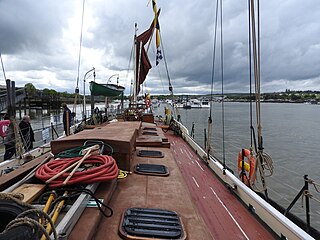
Kitty is a wooden Thames sailing barge in the bowsprit class of 65 tons. She was built in Harwich in 1895. She is No. 209 on the National Historic Ships Register.
